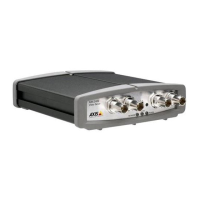14
Axis video server - Video and audio streams
Video and audio streams
The Axis video server provides several different video and audio stream formats. The type
to use depends on your requirements and on the properties of your network.
The Live View page in the Axis video server provides access to Motion JPEG and MPEG-4
video and audio streams, as well as to single JPEG images. Other applications and clients
can also access these video and audio streams/images directly, without going via the Live
View page.
Video stream types
Motion JPEG
This format uses standard JPEG still images in the video stream. These images are then
displayed and updated at a rate sufficient to create a stream that shows constantly updated
motion.
The Motion JPEG stream provides excellent image quality and access to each and every
individual image contained in the stream.
Note also that multiple clients accessing Motion JPEG streams can use different image
settings.
MPEG-4
This is a video compression standard that makes good use of bandwidth, and which can
provide high-quality video streams at less than 1 Mbit/s.
The MPEG-4 standard provides scope for a large range of different coding tools for use by
various applications in different situations, and the Axis video server provides certain
subsets of these tools. These are represented as Video object types, which are selected for
use with different viewing clients. The supported video object types are:
• Simple - sets the coding type to H.263
• Advanced Simple - in Axis products, this sets the coding type to MPEG-4 Part 2
AMC (AXIS Media Control) supports both object types, whilst e.g. QuickTime™ requires the
Simple object type.
When using MPEG-4 it is also possible to control the bit rate, which in turn allows the
amount of bandwidth usage to be controlled. CBR (constant bit rate) is used to achieve a
specific bit rate by varying the quality of the MPEG-4 stream. When using VBR (variable
bit rate), the quality of the video stream is kept as constant as possible, at the cost of a
varying bit rate.

